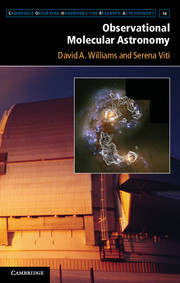Book contents
- Frontmatter
- Contents
- List of Illustrations
- List of Tables
- Preface
- 1 Introduction
- 2 Spectra and Excitation of Interstellar Molecules
- 3 Astrochemical Processes
- 4 Physical Processes in Different Astronomical Environments
- 5 Molecular Tracers in the Milky Way Galaxy
- 6 Molecular Tracers in External Galaxies
- 7 The Early Universe and the First Galaxies
- 8 Recipes for Molecular Submillimetre Astronomy
- 9 Chemical and Radiative Transfer Models
- 10 Observations: Which Molecule, Which Transition?
- Appendix: Acronyms
- Index
- References
9 - Chemical and Radiative Transfer Models
Published online by Cambridge University Press: 05 December 2013
- Frontmatter
- Contents
- List of Illustrations
- List of Tables
- Preface
- 1 Introduction
- 2 Spectra and Excitation of Interstellar Molecules
- 3 Astrochemical Processes
- 4 Physical Processes in Different Astronomical Environments
- 5 Molecular Tracers in the Milky Way Galaxy
- 6 Molecular Tracers in External Galaxies
- 7 The Early Universe and the First Galaxies
- 8 Recipes for Molecular Submillimetre Astronomy
- 9 Chemical and Radiative Transfer Models
- 10 Observations: Which Molecule, Which Transition?
- Appendix: Acronyms
- Index
- References
Summary
In Chapter 8 we covered the basic formulae and recipes that astronomers use to derive physical quantities from molecular observations. These simple LTE analyses provide observers with rough estimates of the density and temperature of the gas at equilibrium. However, molecular observations can also provide much further insight into the physical conditions and the history and dynamics of the gas if interpreted with the right tools. In this chapter we describe the chemical and radiative transfer models that have been developed over many years and we show how a careful use of such tools makes molecules into powerful diagnostics of the evolution and distribution of molecular gas in the interstellar medium. It is now possible for the observer to use well-established modelling codes to exploit the information contained in the observational data and to determine a rather complete description of the observed interstellar material. This chapter discusses the inputs required and the outputs expected from such models.
Chemical Modelling
Owing to the large range of densities and temperatures present in the interstellar medium, significant changes in the energetics and dynamics of the gas can occur, leading to large variations in the chemical abundances. For decades now, chemical simulations (based on the processes described in Chapter 3) have provided astrochemists with predictions of molecular abundances as a function of the physical conditions. However, the interpretation of chemical models is not a trivial task and demands a detailed knowledge of the way the chemical model is developed.
- Type
- Chapter
- Information
- Observational Molecular AstronomyExploring the Universe Using Molecular Line Emissions, pp. 152 - 164Publisher: Cambridge University PressPrint publication year: 2013



